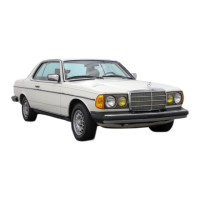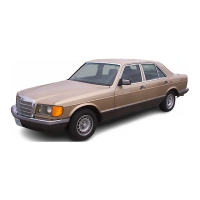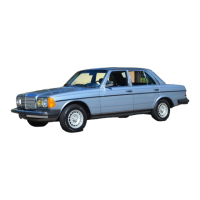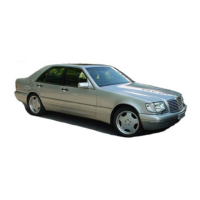
Do you have a question about the Mercedes-Benz 300 D-TURBO DIESEL 1985 and is the answer not in the manual?
| Brand | Mercedes-Benz |
|---|---|
| Model | 300 D-TURBO DIESEL 1985 |
| Category | Automobile |
| Language | English |
Dashboard controls and indicators.
Gauges and indicators on the dashboard.
Instructions for accessing and securing doors.
Features and activation of the alarm.
Adjusting driver and passenger seats.
Operation of the seat heating system.
Proper use and adjustment of headrests.
Functionality of front and rear arm rests.
Fastening, unfastening, and safety for front and rear belts.
Details on emergency tensioning retractors.
Ignition and steering lock positions.
Operation of vehicle exterior and interior lights.
Controls for turn signals, wipers, and headlights.
Features and operation of the cruise control system.
Adjusting interior temperature and fan speed.
Ventilation, cooling, heating, and economy modes.
Air distribution settings for defrosting and comfort.
Specific function for clearing windows.
Adjustment and operation of side mirrors.
Adjustment for night driving.
Functionality of sun visors and integrated vanity lights.
Operation of the rear defroster.
Operation of cabin lighting.
Control and safety features of electric windows.
Operation of the cigarette lighter.
Operation of the sunroof.
Powering on/off and volume control.
Adjusting audio settings and finding stations.
Direct frequency dialing and automatic search.
Storing and recalling radio stations.
Inserting, playing, and ejecting cassettes.
Setting the time and programming the radio timer.
Operation of the power antenna.
Procedures for starting in cold temperatures.
Procedures for starting a warm engine and shutting off the vehicle.
Tread wear, pressure, aquaplaning, and road conditions.
Brake fluid, wear indicators, and fluid levels.
Charge, fuel reserve, and oil pressure indicators.
Oil pressure, coolant temp, emission control, oil consumption.
Preparations and advice for winter conditions.
Advice for slippery roads, salt, and high altitudes.
Service intervals and schedules.
Scheduled inspections and services.
Recommended intervals for oil changes.
Recommendations for brake fluid and coolant.
Availability and quality of genuine parts.
General advice on maintaining the car's appearance.
Proper washing techniques and product recommendations.
Removal of tar spots.
Maintaining visibility.
Cleaning plastic, headliner, and upholstery.
Maintenance of seat belt webbing.
Cleaning interior controls.
Leather and velour cleaning.
Washing, waxing, and touch-up repairs.
Cleaning alloy wheels and ornamental moldings.
Advice on roof racks.
Location of the first aid kit.
Location and use of emergency equipment.
Removal and installation of ash trays.
How to access under the rear seat.
Procedure for fuel system maintenance.
Emergency engine shutdown method.
Visual inspection of coolant reservoir.
Procedure for replenishing coolant.
Checking and maintaining transmission fluid.
Replacement, selection, and break-in of tires.
Benefits and schedule for rotating tires.
Importance and frequency of checking tire pressure.
Procedure for checking engine oil.
Visual inspection of coolant reservoir.
Procedure for replenishing coolant.
Checking and maintaining transmission fluid.
Proper aiming of headlights.
Procedure for changing various bulbs.
Location, replacement, and troubleshooting of fuses.
Checking fluid levels and charging.
Manual operation of the sunroof.
Manual release of the fuel filler flap.
Procedure for jump-starting via towing.
Guidelines for towing with wheels on the ground or lifted.
Using jumper cables to start a discharged battery.
Vehicle physical specifications for different models.
Location of chassis, engine, and other identification tags.
Information on vehicle data cards.
Overview of vehicle warranties.
Details on engine type, displacement, bore, stroke.
Transmission type and steering system design.
Specifications for wheels and tires.
Alternator, starter motor, and battery ratings.
Total oil capacity and recommended grades.
Fluid capacity for automatic transmission.
Capacities for rear axle, power steering, brake reservoir, etc.
Recommended lubricants for various components.
Recommendations for engine oil types and usage.
Importance, replacement, and type of brake fluid.
Fuel types, additives, and cold weather considerations.
Coolant composition, protection levels, and maintenance.
Explanation of tire traction and temperature grades.
Braking performance data under various conditions.











